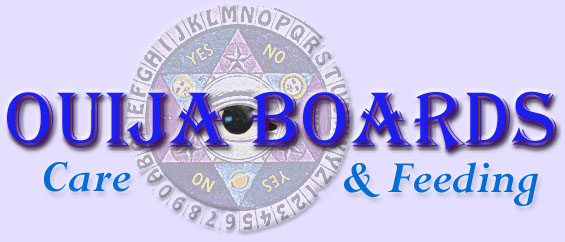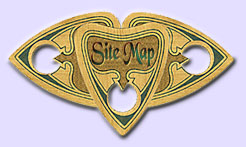
Old talking boards don't always come in the best of shape. Years of shelf dirt plus scuffs and dings can really make a mess of things. One wonders if anything can be done. The answer is yes, and no, depending on the damage and the board. The first thing to caution against is overzealous cleaning. If you are unsure of your skills, it's best to leave it alone. Better to leave it dirty than to damage it further. This is particularly important if your board is a "bona fide antique collectible." Many collectors prefer the look of an old board with its "character" and "patina" intact. Call them crazy.
If your board is in good condition, all that is necessary is an occasional wipe with a soft cloth. Keep it in the original box, or if that is not available, a relatively sturdy box the same size. Store it in a clean dry place. Closets are fine, damp garages are a no-no. Under ideal conditions, you would store your boards in acid free boxes in a controlled dark environment with low humidity and temperature and you wouldn't stack them. We're a little nutty here at the Museum of Talking Boards so we shrink wrap all of our individual boards and boxes. Some don't like the idea of sealing things in plastic and warn of chemical and condensation damage. We haven't found that to be the case with modern shrinkwrapping, and think it a superior way to protect against dirt, shelf wear, and moisture. It's probably a good idea to re-wrap them every couple of years.
For special cleaning and repairing situations, we offer the following list of suggestions:
*Important! Always test clean a small area of the board first. Keep scrubbing to a minimum and be alert for any damage.
General Cleaning
Glass cleaner like Windex or Glass Plus works
wonders on many dirty boards. Spray the cleaner on a clean
white cloth (not on the board directly) and wipe in small
circular patterns. Spot clean, going for the dirtiest areas
first. Try to avoid the printing if at all possible. Dry
immediately with another clean white cloth. This works
great for most varnished wood boards, but look closely.
Some wood boards came unvarnished. There is a good chance
you'll smear those letters all over the place. Old Parker
Brothers and William Fuld paper on hardboard (Masonite)
boards clean very well. Never try to clean Hasko litho
boards with glass cleaner. It's a prescription for ink-dot
disaster. Other boards never to clean are cardboard
boards—particularly those with red and yellow inks. If you
see red ink coming off on your cloth, stop immediately.
Hasko Trays clean up very nicely. Make sure that you have a
Hasko Tray and not a Hasko Tray Board (with the double
lines through the "Tray" on the box). Hasko used the same
box for many of its boards. A tray is a tray and a board is
a board.
Lifting Lithos
If
a small part of the paper litho is peeling from the surface
of the board, you can use rubber cement to glue it back
down. Rubber cement evaporates quickly and is easy to clean
up, making it ideal. As with all glues, use a small amount
and try not to slop it all over. A small, long- handled
artist's brush works best to get under those
edges.
Ply Separation/Warpage
You've got a wood board that's coming apart. What
to do? If the veneer is just beginning to peel and is very
flat, just use some of your rubber cement. Place something
heavy on the board until it dries. Immediately clean up any
glue that squeezes out. If you have very warped veneers
then you need to use a high quality wood glue and wood
clamps to make it right. Consult your local cabinetmaker if
you don't know how to do this. Warped boards with intact
veneers can be straightened by wall mounting them for
several months. Use mirror clips to hold the board flat to
the wall.
Dry, Spotted Boards
Your wood board has those dry spots where the
varnish has worn thin. Take some Old English
(light/blond/natural) Scratch Cover and pour in on. Don't
use the Old English Dark Scratch Cover or you will get dark
spots where the thin varnish is. Not what you intended.
Follow the directions on the bottle. After the board dries
(a day or two) spray on a light coating of Pledge furniture
polish. Some like to use thick furniture wax on their
boards. All that wax buildup can cause cleaning problems
later on, just like on your kitchen floor.
Pen and Ink Marks/Stains and Other Weird
Catastrophes
Johnny wrote his name all over the board with his
new ink pen. Someone scribbled "Damn ye to Hell" and drew
an assortment of pentagrams using a magic marker. Forget
about it. There is nothing you can do. Never take a pencil
eraser to the surface of the board.
Your upstairs neighbor's toilet backed up, leaked through the ceiling, and properly stained your prized Egyptian Hasko Mystic Board. Sorry. The board is toast. There isn't anything you can do. If you shrink-wrapped it, like we do, there wouldn't be a problem. With the board, we mean.
The girls held a midnight séance with your Kennard Feb 10th 1891 talking board. Unfortunately the spirits were rowdy and spilled candle wax all over it. Next time give them a flashlight. There isn't anything you can do. The wax is there to stay. Pick off what you can with your fingernails, but those grease spots are permanent. Don't try any of those "iron over newspaper" carpet tricks your mother taught you. They won't work here.
Refinishing Old Boards
You're bound and determined to refinish that
scruffy old Fuld board and are not about to let us talk you
out of it. Go ahead and clean the board as best you can,
color in those faded letters and apply the stain of your
choice. When it dries, load on the
varnish/polyurethane/varathane/whatever super finish and
you're all done. Good luck. The antique value of your board
has just plummeted by two hundred percent. But it looks
great, maybe, and perhaps that's all that matters. If you
are going to take this route, experiment on some junk
plywood scraps first. You want to have your staining and
finishing technique down pat.
Planchette Repair
If
your planchette is missing the wooden pegs you can make
decent replacements using a wood dowel from the local
hardware store. Cut to the proper size and glue the pieces
in place. Stain them to match the planchette. Cut felt
circles and glue them to the bottom of the pegs using
rubber cement. Some hardware stores and hobby shops sell
pre-cut felt circles with adhesive backs, so be sure to
look for them. If your planchette has contoured pegs and
you must have exact replacements, take an existing peg to a
cabinet shop and have it copied. Expect to pay much more
than the planchette is worth.
Cracked and broken planchettes require special glues and clamping. Leave it to a professional.
 Missing the
plastic window and original brass "pointing needle?" Trek
on down to your stationary store. We have found that the
clear plastic covers on greeting card boxes are just about
the perfect thickness. Cut out a circle with a pair of
sharp scissors and pop it in the hole. Find a close
replacement for the brass "pointing needle" in any hardware
store. Look for brass finishing tacks in the nails section.
If you need the original metal ring for your wood Fuld
planchette, you are plumb out of luck. They aren't
available anywhere.
Missing the
plastic window and original brass "pointing needle?" Trek
on down to your stationary store. We have found that the
clear plastic covers on greeting card boxes are just about
the perfect thickness. Cut out a circle with a pair of
sharp scissors and pop it in the hole. Find a close
replacement for the brass "pointing needle" in any hardware
store. Look for brass finishing tacks in the nails section.
If you need the original metal ring for your wood Fuld
planchette, you are plumb out of luck. They aren't
available anywhere.
What to Do With a Board When All Is
Lost
Old wood Ouija boards make wonderful patches for
attic holes plus have the added advantage of freaking out
prospective home buyers. Play the movie "The Exorcist"
during open house. If you're the artsy-fartsy type you can
float off those old Parker Brothers lithos in the bathtub.
Use them to make Ouija-themed book covers, garbage cans,
and coasters, that sort of thing. Or take that
candle-waxed, pen-scribbled, bent, warped, peeling, stinky
Ouija board and concoct a wonderful story about it. Say
that it is haunted and linked to some horrible murders.
Suggest that the surface stains may actually be human
blood. Auction it on eBay. Set the reserve price
impossibly high. Watch the money roll in. Or not, depending
on the phase of the moon and the number of savvy bidders at
the time.
